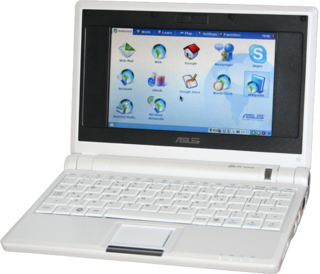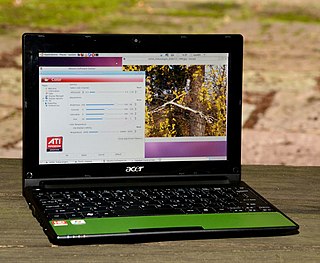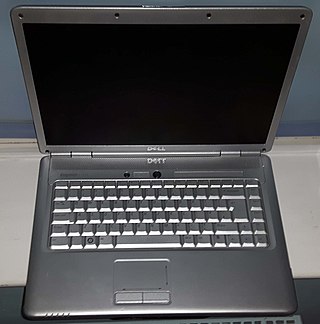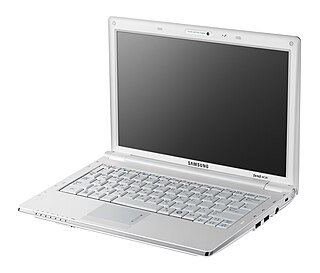
Dell XPS is a line of consumer-oriented laptop and desktop computer series manufactured by Dell since 1993.

The Panasonic Toughbook is a line of rugged computers produced and marketed by Panasonic. The first model, the CF-25, was introduced in 1996. The Toughbook brand mainly competes with other lines of rugged computers, such as Dell's Rugged Extreme.

An ultra-mobile PC, or ultra-mobile personal computer (UMPC), is a miniature version of a pen computer, a class of laptop whose specifications were launched by Microsoft and Intel in Spring 2006. Sony had already made a first attempt in this direction in 2004 with its Vaio U series, which was only sold in Asia. UMPCs are generally smaller than subnotebooks, have a TFT display measuring (diagonally) about 12.7 to 17.8 centimetres, are operated like tablet PCs using a touchscreen or a stylus, and can also have a physical keyboard. There is no clear boundary between subnotebooks and ultra-mobile PCs, but UMPCs commonly have major features not found in the common clamshell laptop design, such as small keys on either side of the screen, or a slide-out keyboard.

The Samsung Q1 was a family of ultra-mobile PCs produced by Samsung Electronics starting in 2007. They had a 7" (18 cm) LCD and were made in several different versions with either Windows XP Tablet PC Edition or Windows Vista Home Premium.
The Classmate PC, formerly known as Eduwise, is Intel's entry into the market for low-cost personal computers for children in the developing world. It is in some respects similar to the One Laptop Per Child (OLPC) trade association's Children's Machine (XO), which has a similar target market. Although made for profit, the Classmate PC is considered an Information and Communication Technologies for Development project (ICT4D). Introduced in 2006, the device falls into the then popular category of netbooks.

The ASUS Eee PC is a netbook computer line from Asus, and a part of the ASUS Eee product family. At the time of its introduction in late 2007, it was noted for its combination of a lightweight, Linux-based operating system, solid-state drive (SSD), and relatively low cost. Newer models added the options of Microsoft Windows operating system and rotating media hard disk drives (HDD), and initially retailed for up to 500 euros.

Dell Vostro is a line of business-oriented laptop and desktop computers manufactured by Dell aimed at small to medium range businesses. From 2013–2015, the line was temporarily discontinued on some Dell websites but continued to be offered in other markets, such as Malaysia and India.

The ECS G10IL is a netbook computer designed by ECS. Using an Intel Atom N270 processor, it includes a built-in tri-band HSDPA and HSUPA, the "Super 3G". The notebook is available with Linux or Windows XP.

Acer Aspire One is a line of netbooks first released in July 2008 by Acer Inc.
These tables provide a comparison of netbooks.

The Skytone Alpha-400 is a Linux-based low-cost netbook with a 7 in 800×480 LCD screen, introduced in 2008. Its measurements (length×width×depth) are 210×140×32 mm and it weighs 0.65 kg.

The Sony Vaio P series is a range of ultraportable subnotebook computers launched in January 2009.
The Dell Inspiron Mini Series is a line of subnotebook/netbook computers designed by Dell. The series was introduced in September 2008 amidst the growing popularity of low-cost netbook computers introduced by competitors.

The Inspiron 1525 is a laptop designed and distributed by Dell as part of their Inspiron product line. There is also an AMD variant known as the Inspiron 1526. The laptop is the successor to the Inspiron 1520, and was released on January 4, 2008. This computer was available to purchase on the Dell website, where it could be customized to the user's specification.

The Samsung NC20 is a subnotebook / Netbook computer designed by Samsung. At the time of its introduction,, it was the first mainstream netbook to use the VIA Nano processor and the first to support the x86-64 instruction set. The 12.1" screen size is larger than typical for this class of ultra portable PC. Its most direct competitors are the Lenovo IdeaPad S12 and the MSI Wind U210.

The IdeaPad S12 is a line of consumer-oriented netbook computers designed by Lenovo. It is a model in the IdeaPad series and their first netbook to have a 12" screen. The computers were put on the market in 2009 and currently come in black and white.

HP Mini is a former line of small computers categorized as netbooks manufactured by Hewlett-Packard. They either contained a custom version of Ubuntu Linux, Microsoft Windows XP Home Edition or Windows 7 Starter operating system. Like most netbooks, they were not built with CD/DVD drives. They were announced from mid-2007, and marketed from 2008 through 2012.

The Samsung N130 is a subnotebook/netbook computer designed by Samsung. At the time of its introduction, it was noted for a good keyboard, large 6-cell battery as standard, giving a battery life of up to 7.5 hours a medium 160gb SATA hard disk drive and a release price of 349 USD.
Bonnell is a CPU microarchitecture used by Intel Atom processors which can execute up to two instructions per cycle. Like many other x86 microprocessors, it translates x86 instructions into simpler internal operations prior to execution. The majority of instructions produce one micro-op when translated, with around 4% of instructions used in typical programs producing multiple micro-ops. The number of instructions that produce more than one micro-op is significantly fewer than the P6 and NetBurst microarchitectures. In the Bonnell microarchitecture, internal micro-ops can contain both a memory load and a memory store in connection with an ALU operation, thus being more similar to the x86 level and more powerful than the micro-ops used in previous designs. This enables relatively good performance with only two integer ALUs, and without any instruction reordering, speculative execution or register renaming. A side effect of having no speculative execution is invulnerability against Meltdown and Spectre.

The IdeaPad S Series is a series of notebook computers launched by Lenovo in October 2008. The IdeaPad S10 was initially scheduled for launch in September, but its release was delayed in the United States until October.

















